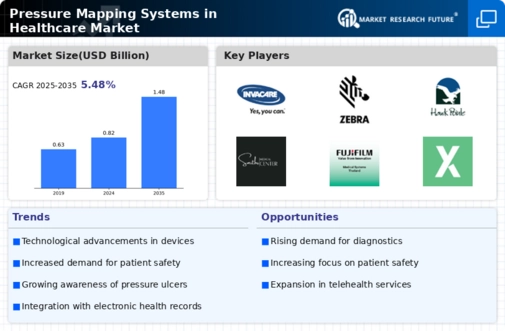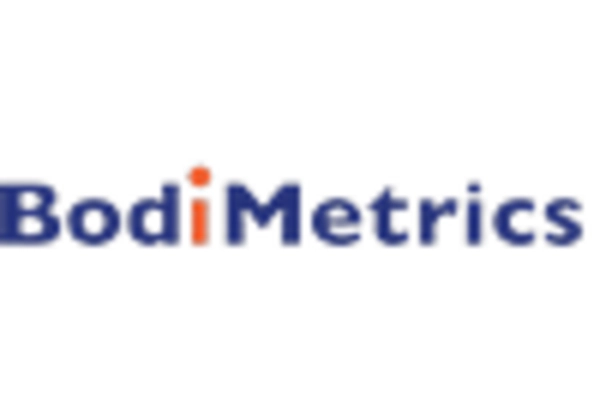Growing Emphasis on Patient Safety
The heightened focus on patient safety within healthcare institutions is a significant driver for the Pressure Mapping Systems in Healthcare Market. Regulatory bodies and accreditation organizations are increasingly mandating the implementation of safety protocols to minimize the risk of pressure ulcers and other complications. This shift towards prioritizing patient safety has led to a surge in the adoption of pressure mapping systems, which provide essential insights into pressure distribution and patient positioning. By utilizing these systems, healthcare providers can proactively identify at-risk patients and implement preventive measures. As the emphasis on patient safety continues to grow, the Pressure Mapping Systems in Healthcare Market is expected to experience robust growth, driven by the need for effective tools that enhance patient care and safety.
Rising Incidence of Pressure Ulcers
The increasing prevalence of pressure ulcers in healthcare settings is a primary driver for the Pressure Mapping Systems in Healthcare Market. Studies indicate that approximately 2.5 million patients develop pressure ulcers annually, leading to significant healthcare costs and complications. This alarming statistic underscores the necessity for effective prevention and management strategies. Pressure mapping systems provide healthcare professionals with critical data on pressure distribution, enabling timely interventions. As healthcare facilities strive to enhance patient outcomes and reduce the financial burden associated with pressure ulcers, the demand for advanced pressure mapping technologies is likely to rise. Consequently, this trend is expected to propel the growth of the Pressure Mapping Systems in Healthcare Market, as institutions seek innovative solutions to address this pressing issue.
Integration with Telehealth Services
The integration of pressure mapping systems with telehealth services is emerging as a key driver in the Pressure Mapping Systems in Healthcare Market. As telehealth becomes increasingly prevalent, healthcare providers are seeking ways to incorporate advanced technologies that enhance remote patient monitoring. Pressure mapping systems can be integrated into telehealth platforms, allowing for real-time assessments of patients' pressure distribution from the comfort of their homes. This capability not only improves patient engagement but also enables healthcare professionals to make informed decisions regarding patient care. The growing acceptance of telehealth solutions suggests a promising future for the Pressure Mapping Systems in Healthcare Market, as providers look to leverage these technologies to improve patient outcomes and streamline care delivery.
Technological Innovations in Pressure Mapping
Technological advancements play a crucial role in shaping the Pressure Mapping Systems in Healthcare Market. Innovations such as real-time data analytics, enhanced sensor technologies, and user-friendly interfaces are transforming how pressure mapping systems operate. These advancements allow for more accurate assessments of pressure distribution, facilitating better patient care. For instance, the integration of wireless technology enables seamless data transfer and remote monitoring, which is particularly beneficial in busy healthcare environments. As healthcare providers increasingly recognize the value of these innovations, the market for pressure mapping systems is anticipated to expand. The continuous evolution of technology in this sector suggests a promising future for the Pressure Mapping Systems in Healthcare Market, as stakeholders seek to leverage these advancements for improved patient outcomes.
Increased Investment in Healthcare Infrastructure
The ongoing investment in healthcare infrastructure is a vital driver for the Pressure Mapping Systems in Healthcare Market. Governments and private entities are allocating substantial resources to enhance healthcare facilities, particularly in developing regions. This investment often includes the acquisition of advanced medical technologies, such as pressure mapping systems, to improve patient care and operational efficiency. As healthcare facilities expand and modernize, the demand for innovative solutions that address patient needs is likely to grow. Consequently, the Pressure Mapping Systems in Healthcare Market stands to benefit from this trend, as healthcare providers seek to implement state-of-the-art technologies that enhance patient outcomes and optimize resource utilization.

















Leave a Comment